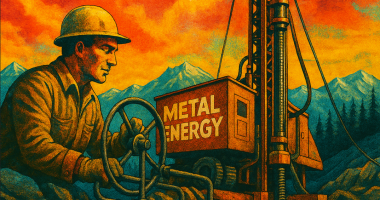ION Energy is in the business of exploration and development of lithium brine in Mongolia.
ION is currently focused on two projects, their flagship project just 24 km from the Chinese border and another bringing their company to a total of over 110 thousand hectares of highly prospective lithium brine assets.
Joining us today is ION’s CEO, Ali Haji to shed some light on the company’s current exploration efforts.
Thank you for joining me, Ali.
TMH: You were in Mongolia for another strategic site visit in the Fall. What should investors know about ION’s exploration progress?
AH: Well, ION has had the ability to advance Urgakh Naran, our secondary asset, in the past year. You know, behind our peers, we’ve been about 12 to 18 months lagging, if you will, purely because Mongolia has not had the necessary skill set to advance lithium assets. So 2022 was ultimately the year that we had an opportunity to advance our assets in terms of exploration objectives and procedures that would mirror very much what you would expect to see in LATAM or Nevada or any other lithium jurisdiction in the world. With respect to what we’ve accomplished in the past year, we’ve done 83 holes. We’ve seen very high anomalies of lithium. We’ve seen a surface sample of 918 milligrams per litre, which is rather exciting. But more importantly, we completed a TM geophysics survey that shows us about 9.9 billion cubic meters at half an Ohm cutoff and 22.7 billion cubic meters at six and a half Ohm cutoff. That prompted us to do a Diamond Lithological drilling program down to about 950 meters across three holes. We’ve seen results there that are rather promising, and that prompted us, of course, to do the water well holes that we’ve now commenced in the process of completing.
TMH: What is so significant about the two lithological diamond core holes being completed?
AH: They’ve been rather exciting. You look at the basin, it’s a closed basin, fault-bound that there is no exit to an external body of water, and through those lit logical holes, we’ve seen grades of up to 278 PPM over 122 meters from 123 meters. At UNDH-01, at UNDH-02, we’ve seen a hundred meters at 362 PPM from 65 meters, again with an average or top grade of 601 ppm and then at UNDH-03, we’ve seen 71.4 meters at 360 PPM from 3.6 meters at from surface and of course with the high grade of 911 ppm. Why that’s important for our viewers or our listeners to understand. If you look at Albemarle Silver Peak Mine in Nevada, it is the only brine-producing asset in North America today and based on their historical little logical drilling results, 121 ppm was their average grade. We’re seeing well in excess of 300, and this is why our viewers and our readers should pay attention to the story.
TMH: What can you tell us about the drilling of one water well down to 300m?
AH: The water wells have been drilled. They were drilled using a tricone bit, six inches in diameter. We’ve put in place slotted steel pipes that allow the brine to flow into those columns. We also have gravel packed along each side to ensure porosity does continue and flow rates are unimpeded, and the two water wells that have now been completed will allow us to collect brine samples. The third is underway, and we expect to have a Baylor system down in those water wells over the course of the next few months, ultimately allowing us to calculate an inferred resource in due course.
TMH: What are you hoping to find from the assay results of samples taken from Urgakh Naran, and how soon do you think investors will get news of these results?
AH: Well, as I mentioned, the lithological holds have shown us that this is an impregnated basin, a basin that contains a fair bit of lithium grades which are higher than those seen at Albemarle Silver Peak Mine. In terms of what you can expect as an investor for ION Energy, we are going to put the Balor systems down into those water wells, collect brine samples from various steps along various intervals, calculate an average grade and then use that alongside the volume metrics that we put together through our TMs, so the geophysics to arrive at an inferred resource. So the inferred resource is impending, I would like to say Q1, but I’d very much like to stick with the H1 of 2023 as far as an inferred resource on Urgakh Naran being announced to the market.
TMH: What is the status of the Baavhai Uul Lithium Brine project?
AH: Baavhai Uul continues to be explored. Of course, we acquired the license when there was no access in-country, and we went public during the height of the pandemic. There were a number of drilling programs that were undertaken on-site. We did about 222 auger holes across the entire asset. We found some very high anomalies of 1,502 PPM lithium at the White Wolf Prospect, and that is exciting Baavhai Uul remains relatively early stage, and we expect to advance that once we’ve had a better understanding of Urgakh Naran. We can deploy the same principles and methodologies of exploration that we employed on Urgakh Naran.
TMH: What are some of your most memorable moments as CEO in the past year?
AH: I would have to say that the site visit in the Spring of 2022 with Dr. Mark King and Don Haynes, gentlemen that were very instrumental in advancing both Lithium Americas and Neo Lithium, having walked over the site for the first time in over two years, collecting brine samples of 918 milligrams per litre on surface, which would either mirror or exceed the vast majority of brine that you would expect to find in LATAM; where the vast majority of the lithium is produced today. Beyond that, of course, the TEM study looking at 9.9 billion cubic meters at half an Ohm cutoff that’s rather exciting. Having seen the drilling results from the lithological holes that we now completed and, of course, the grades that are associated with those holes continue to be a rather exciting time for the company and me, of course.
TMH: With the past year being so exciting, what should investors be anticipating from ION Energy for 2023?
AH: For 2023, the company can expect to announce an inferred resource on our Urgakh Naran project. That is something that we’ve always looked to do, and we will continue to have that goal. We also continue to advance conversations with strategic investors. So the goal for us as a company, as ION Energy, would be to bring in a strategic investor for a tool holder in the organization and ultimately help de-risk the asset. The vast majority of assets around the world today, including LATAM, have a proximity play. So my neighbour has X grade and, and they’ve been able to prove X reserve. That’s something that Mongolia does not have. We’re first movers. We’re first in the country. We have no proximity play, and the goal for us as a company is to ensure that we’re able to compare apples to apples in a relative sense based on what we’re able to find in the country.
Thanks again for joining me today, Ali, We look forward to hearing more from the company in the future.
ION Energy is trading on the TSXV under the ticker symbol ION, and you can also learn more at ionenergy.ca.
I’m Daniella Atkinson for the Market Herald, thanks for watching Topline.
FULL DISCLOSURE: This is a paid article produced by The Market Herald.



